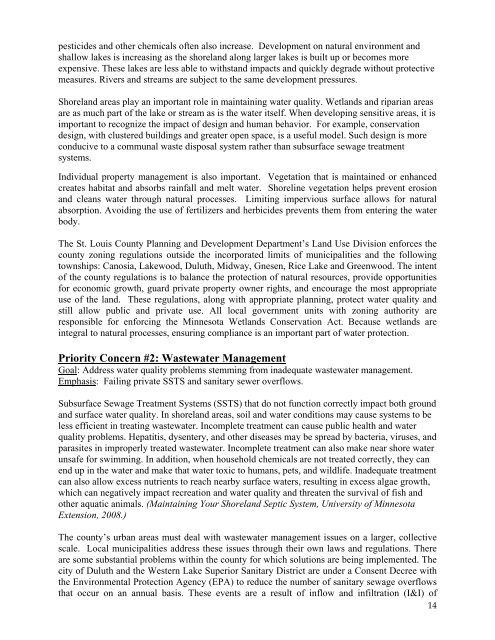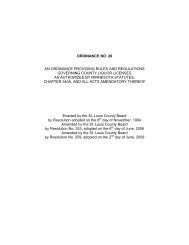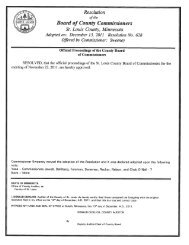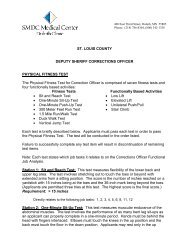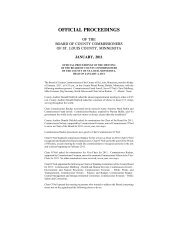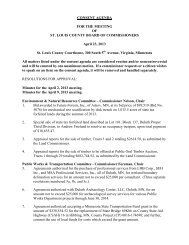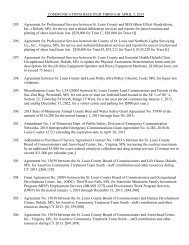Comprehensive Water Management Plan - St. Louis County
Comprehensive Water Management Plan - St. Louis County
Comprehensive Water Management Plan - St. Louis County
You also want an ePaper? Increase the reach of your titles
YUMPU automatically turns print PDFs into web optimized ePapers that Google loves.
pesticides and other chemicals often also increase. Development on natural environment andshallow lakes is increasing as the shoreland along larger lakes is built up or becomes moreexpensive. These lakes are less able to withstand impacts and quickly degrade without protectivemeasures. Rivers and streams are subject to the same development pressures.Shoreland areas play an important role in maintaining water quality. Wetlands and riparian areasare as much part of the lake or stream as is the water itself. When developing sensitive areas, it isimportant to recognize the impact of design and human behavior. For example, conservationdesign, with clustered buildings and greater open space, is a useful model. Such design is moreconducive to a communal waste disposal system rather than subsurface sewage treatmentsystems.Individual property management is also important. Vegetation that is maintained or enhancedcreates habitat and absorbs rainfall and melt water. Shoreline vegetation helps prevent erosionand cleans water through natural processes. Limiting impervious surface allows for naturalabsorption. Avoiding the use of fertilizers and herbicides prevents them from entering the waterbody.The <strong>St</strong>. <strong>Louis</strong> <strong>County</strong> <strong>Plan</strong>ning and Development Department’s Land Use Division enforces thecounty zoning regulations outside the incorporated limits of municipalities and the followingtownships: Canosia, Lakewood, Duluth, Midway, Gnesen, Rice Lake and Greenwood. The intentof the county regulations is to balance the protection of natural resources, provide opportunitiesfor economic growth, guard private property owner rights, and encourage the most appropriateuse of the land. These regulations, along with appropriate planning, protect water quality andstill allow public and private use. All local government units with zoning authority areresponsible for enforcing the Minnesota Wetlands Conservation Act. Because wetlands areintegral to natural processes, ensuring compliance is an important part of water protection.Priority Concern #2: Wastewater <strong>Management</strong>Goal: Address water quality problems stemming from inadequate wastewater management.Emphasis: Failing private SSTS and sanitary sewer overflows.Subsurface Sewage Treatment Systems (SSTS) that do not function correctly impact both groundand surface water quality. In shoreland areas, soil and water conditions may cause systems to beless efficient in treating wastewater. Incomplete treatment can cause public health and waterquality problems. Hepatitis, dysentery, and other diseases may be spread by bacteria, viruses, andparasites in improperly treated wastewater. Incomplete treatment can also make near shore waterunsafe for swimming. In addition, when household chemicals are not treated correctly, they canend up in the water and make that water toxic to humans, pets, and wildlife. Inadequate treatmentcan also allow excess nutrients to reach nearby surface waters, resulting in excess algae growth,which can negatively impact recreation and water quality and threaten the survival of fish andother aquatic animals. (Maintaining Your Shoreland Septic System, University of MinnesotaExtension, 2008.)The county’s urban areas must deal with wastewater management issues on a larger, collectivescale. Local municipalities address these issues through their own laws and regulations. Thereare some substantial problems within the county for which solutions are being implemented. Thecity of Duluth and the Western Lake Superior Sanitary District are under a Consent Decree withthe Environmental Protection Agency (EPA) to reduce the number of sanitary sewage overflowsthat occur on an annual basis. These events are a result of inflow and infiltration (I&I) of14


